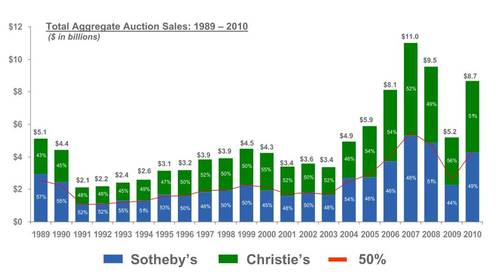The popularity of Sotheby's and Christie's even after such a big conspiracy that resulted in civil and criminal (for Sotheby's) settlements seems to indicate that the role of auction houses in the art world is one that is immense and essential. Although there was a decrease in total auction sales in the years immediately following the price-fixing scandal, both of the two auction houses survived. In fact, with the exception of the year 2009 when the major economic crash hit the nation, they're doing more than okay (see graph). Bill Ruprecht, Sotheby's president and CEO, revealed his confidence for the future auctions, believing that for the very rich, art collecting makes people feel "more confident with this group of works as a way for them to deploy significant capital" (Rosenbaum). That's it- I think that as long as people see art as just another category in their investment portfolio, art auction will continue to be in demand.
[http://www.artsjournal.com/culturegrrl/assets_c/2011/08/AuctMrkShr2-thumb-500x276-20343.jpg]![]()
The tactics of Sotheby's and Christie's to attract big sales by big sellers do not seem to have changed after the scandal. They continue to grant sellers guarantees (promised sums of money to be paid to sellers regardless of a sale's outcome) and share of the premiums paid by buyers. With constant competition over the dominance in the art auction world, the rivalry between Sotheby's and Christie's doesn't seem to ever end. According to one art market blog, the auction houses even wave their fees "in an effort to secure the sale of a particular artwork or collection just so they can get the resulting publicity and kudos" (Forrest).
...
